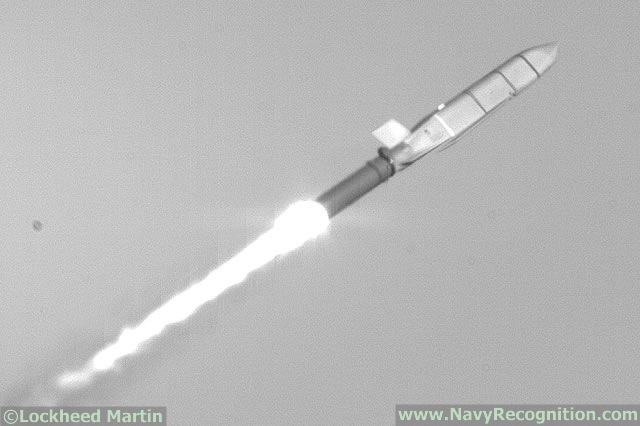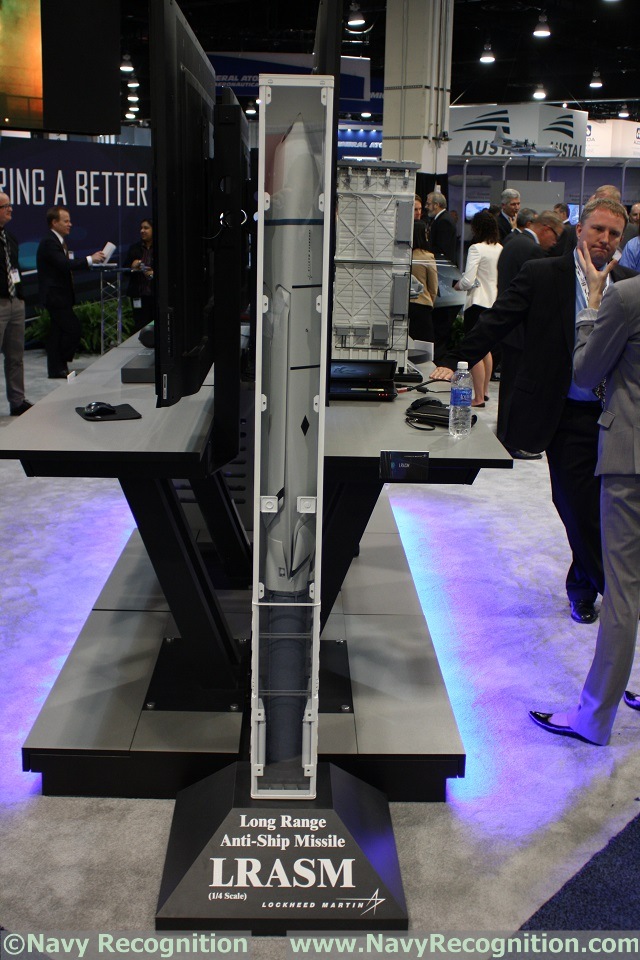| |
| a |
DSEI
2015 Naval Daily News - Lockheed Martin LRASM |
DSEi
2015: Lockheed Martin Eager to See its LRASM On Board Royal Navy's Type
26 Frigates |
During DSEI 2015 which took place in London from 15-18 September, Navy
Recognition met with Frank St. John, vice president at Lockheed
Martin Missiles and Fire Control. We discussed Long Range Anti-Ship
Missile (LRASM) program update as well as the possibility to see Lockheed
Martin's next generation anti-ship missile fitted one day on board the
Royal Navy's future Type
26 Frigates. |
 September 2014 "CTV-1" flight test demonstrating integration
with Tactical Tomahawk Weapons Control System (TTWCS) and Mk41 VLS. This
test also demonstrated vertical launch egress, boost phase, booster separation
and transition to cruise.
September 2014 "CTV-1" flight test demonstrating integration
with Tactical Tomahawk Weapons Control System (TTWCS) and Mk41 VLS. This
test also demonstrated vertical launch egress, boost phase, booster separation
and transition to cruise. |
|||
Navy Recognition
learned that LRASM critical design review (CDR) is set to happen
in seven months and that part of the CDR includes review of export policy.
Frank St. John reminded us that the "A, B, C countries" (Australia,
Great Britain, Canada) are typically the first U.S. Allies to get the
green light for procurement of the latest U.S. made military technology.
"Type 26 will be fitted with MK 41 vertical launching system and I believe LRASM would be a good fit for these vessels" added Frank St. John. Talking about Australia, he explained that the country is faced with the same threats that led the United States to develop the LRASM and the fact that the Royal Australian Air Force already deploys F/A-18s should also be seen as a good opportunity. Speaking more broadly about LRASM program updates, Frank St. John explained that part the expansion of a cruise missile facility in Alabama is for production of LRASM and this shows that everything is on track. The U.S. Defense Advanced Research Projects Agency (DARPA) will soon transition LRASM program management to the U.S. Navy. "We think the LRASM is a very good missile to answer the U.S. Navy anti-ship missile requirements" concluded Frank St. John. |
|||
 Scale model: LRASM inside a MK 41 VLS cell (Pictured at SAS 2015) |
|||
We
reported in August that the U.S. Navy began initial integration
testing of its AGM-158C Long-Range Anti-Ship Missile (LRASM) onto the
F/A-18E/F Super Hornet at Patuxent River’s Air Test and Evaluation
Squadron (VX) 23 facility. The program's flight test team is conducting
initial testing to ensure proper loading, unloading and handling of
the LRASM on the F/A-18 E/F. When operational, LRASM will provide flexible, long-range, advanced, anti-surface capability against high threat maritime targets. This missile development program is a joint effort of the Defense Advanced Research Projects Agency, Naval Air Systems Command, the United States Air Force. the Office of Naval Research (ONR) with Lockheed Martin as prime contractor. The missile is fitted with BAE Systems' advanced long range sensor which is designed to enable targeted attacks within a group of enemy ships protected by sophisticated air defense systems. Lockheed Martin is developing on its own funds a vertical launched variant compatible with the MK 41 VLS. Lockheed Martin has successfully launched at least two Vertical Launch System (VLS) surface-launch LRASMs from a Desert Ship at White Sands Missile Range, New Mexico and continues subsystem testing to mature technology in anticipation of an upcoming U.S. Navy OASuW Increment II competition. The LRASM is a long-range subsonic cruise missile designed for better range and survivability than current anti-ship weaponry. It is carried with the wings and tail stowed and then deployed once released from the aircraft. LRASM is set to be fielded on the U.S. Air Force B-1B Bomber in 2018 and the U.S. Navy F/A-18 E/F in 2019. To learn more: Link to LRASM Long Range Anti-Ship Missile technical datasheet. |
|||
New
Type 26 Frigate animation releazed by BAE Systems during DSEI 2015 |
|||










